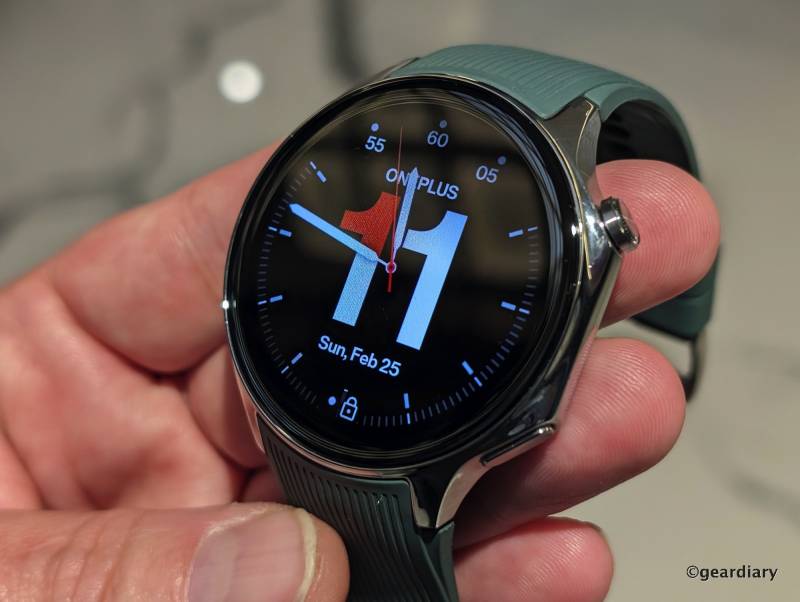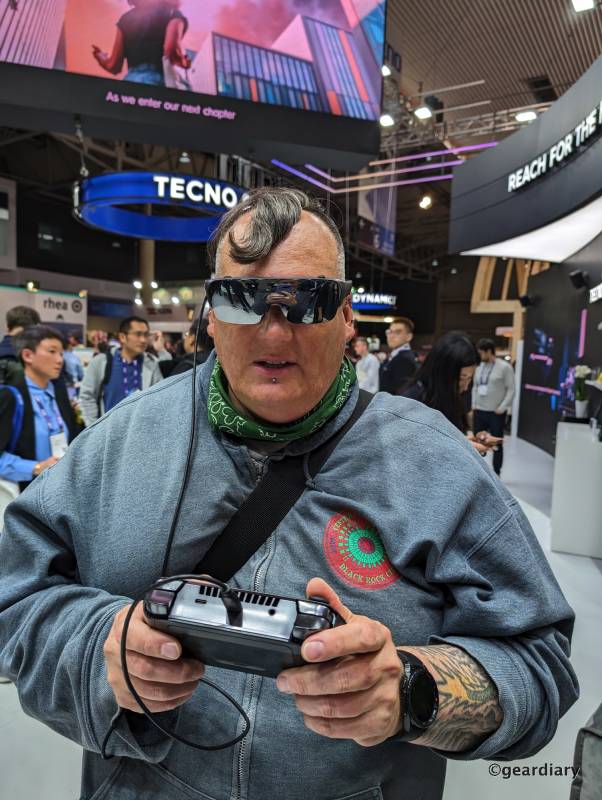Mobile World Congress (MWC) – the trade show that’s all about mobile tech – just took place in Barcelona last week, so here’s a recap of the best stuff I saw at the event. Not surprisingly, AI was the buzzword du jour at MWC this year – just like it was at CES in January – but this didn’t detract from manufacturers launching some interesting products and showing off exciting concepts.

Image Credit: Michael Fisher
OnePlus
OnePlus launched the $299 Watch 2, a Wear OS smartwatch with a 100-hour (4-day) battery life. What matters here is the new Wear OS hybrid interface, which offloads some tasks – like the always-on display, health and fitness tracking, and notifications – from the Wear OS application processor to a microcontroller running a lightweight RTOS (real-time OS).
This results in dramatically improved battery life without sacrificing performance.

The company also announced the OnePlus 12R Genshin Impact Edition, a Keqing-themed 16/256GB variant of the 12R that costs just $50 more ($649) and comes in a single delightful color: Electro Violet.
Beyond the Keqing-themed etched rear glass and user interface, the box contains unique collectibles, including a purple case, 100W charger, right-angle USB cable, and a custom SIM removal tool.
Lenovo
Lenovo unveiled the AI-ready, Intel Core Ultra-equipped ThinkBook 14 2-in-1 Gen 4 laptop, but what’s way more exciting is the ThinkBook Transparent Laptop the company showcased at the show.
It’s a concept laptop with a 17.3-inch micro-led transparent display and a rear-facing camera that enables AR applications. For example, the laptop was able to land a virtual bee on a real bouquet of flowers placed behind the transparent screen.
In addition, the company launched ThinkPad T14, T14i, and T14s Gen 5 laptops that feature Intel Core Ultra and Ryzen 8040 processors, plus a revised internal design that makes these systems easier to repair by end-users and IT departments alike.
The team from iFixit was on hand to highlight the changes, including captive screws, swappable RAM (vs. soldered on), and parts labeled with QR codes with links to repair instructions.
Motorola
Motorola surprised everyone with the Adaptive Display Concept, which is best described as a bendy concept phone.
Unlike foldables like the Moto Razr, which fold in half to hide the main display, this device uses a flexible OLED screen mounted on a segmented frame covered in a fabric-like material that can be seamlessly bent into a C, L, or U shape – or even wrapped around your wrist like a giant smartwatch.
It’s cool (especially the cobra-like L shape), but what’s really interesting is how the user experience adapts to the shape of the device.
This concept behaves like a phone when flat or slightly curved (C shape). Bend it into a tent-like shape (inverted U), and two people can use the display simultaneously to play Connect Four.
Wrap it around your wrist, and you get widgets like on the Razr’s cover display. Clever!
Honor
Honor unveiled the €1299 Magic6 Pro flagship and €2699 Magic V2 RSR Porsche Design folding phone, both leaning heavily on AI features.
Neither is coming to the US, but the Magic 6 Pro stands out thanks to a 180-megapixel 2.5x periscope telephoto and 5600mAh silicon-carbon battery. As for the Magic V2 RSR, it’s the luxury edition of the ultra-thin Magic V2 foldable that launched at IFA last year, re-skinned by Porsche Design.

HMD Global
HMD Global announced that in addition to using the Nokia brand, it will start making handsets under its own brand later this year, using the backronym Human Mobile Devices. It also revealed that it’s collaborating with Mattel on a Barbie dumbphone.
More importantly, HMD is bringing modularity back to smartphones with Fusion, which will allow anyone with a 3D printer to create “outfits” (or smart cases) for its upcoming phones.
Xiaomi
Xiaomi launched the global version of the €999 Xiaomi 14, a compact (6.3-inch) Snapdragon 8 Gen 3-powered flagship with Leica cameras.
In addition, the company revealed the €1,499 Xiaomi 14 Ultra, a cameraphone powerhouse with quad 50MP Leica rear shooters – including a variable aperture 1-inch main sensor and a 5x periscope telephoto – that competes squarely with Oppo’s imaging uber-flagship, the Find X7 Ultra.

Other new products include the Snapdragon 8 Gen 2-equipped Xiaomi Pad 6S Pro 12.4 tablet, the Watch 2 running Wear OS, and the HyperOS-powered Watch S3 – which features interchangeable bezels with matching bands and watch faces.
But what really stood out at Xiaomi’s booth was the company’s first EV, the SU7. This sporty car is clearly inspired by the Porsche Taycan and delivers up to 673 horsepower with a range of about 325 miles.
Humane
Humane was demonstrating its $699 AI Pin at the Qualcomm booth. This was the first time the device was being shown to a broad audience, and it gathered large crowds.
It’s small and features a touch area, a “trust light,” a wide-angle camera, a depth sensor, a laser projector, and hot-swappable batteries that magnetically clip to the back of the device, holding it in place on your clothes. You talk to it, and it uses generative AI to respond.
The (monochrome green) laser projector can display stuff on the palm of your hand. A time-of-flight (ToF) depth sensor detects your hand and finger gestures and lets you interact with the projected interface.
While this device’s tech is state-of-the-art – and undeniably cool – its usefulness remains to be seen. Plus, Humane’s marketing for the AI Pin has made the company come off as self-important, which is off-putting.
ZTE
ZTE unveiled several phones, including the $799 Nubia Z60 Ultra flagship – which boasts a 35mm main camera and 6000mAh battery – and the $599 Nubia Flip 5G, an affordable folding flip phone with a circular cover screen and Snapdragon 7 Gen 1 chip.
Both devices are coming to the US, which is great news. The company also showed the Nubia Music, a colorful budget handset with a massive speaker and dual headphone jacks.
OPPO
Oppo launched the Air Glass 3 smart glasses. At just 50g, these are the lightest smart glasses available today, and like Ray-Ban’s Meta glasses, these look pretty much like regular glasses.
Unlike Ray-Ban’s Meta glasses, the Air Glass 3 have no cameras and are AR smart glasses with two bright (1000 nits) waveguide displays. They are powered by OPPO’s own generative AI and will be available in China soon, with pricing to be determined.
Tecno
Tecno crashed MWC with the Pocket Go (pricing TBD), a game controller that incorporates a Ryzen 7 8840H processor for serious PC gaming and connects to a pair of AR glasses that pack two 0.71-inch micro-OLED displays.
With this futuristic device, you can play Windows games anywhere on a 215-inch virtual screen floating 20ft away. The AR glasses don’t require prescription inserts thanks to a focus dial and incorporate haptic audio.

Samsung
Samsung showcased the Galaxy Ring, the health and wellness wearable the company originally teased at Unpacked back in January.
This smart ring will come in three colors (silver, gold, and dark gray) and nine sizes (5 to 13) and should last several days on a charge. Unlike the Oura Ring, the Galaxy Ring’s cross-section is concave, making it easier to remove. You can expect a focus on sleep, basic vitals tracking, and a summer launch.
Nothing
Nothing revealed the design for the Phone (2a), a MediaTek Dimensity 7200 Pro-equipped mid-range phone that’s launching March 5.
This more affordable handset – which will be available in both black and white – is meant to deliver the same polished user experience as Phone (2) without prioritizing specs, all while still including Nothing’s iconic Glyph lights in the back. Stay tuned for pricing.
The Rest at MWC
A few lesser-known Shenzhen-based brands unveiled affordable folding flip phones – strangely, all powered by MediaTek’s budget Helio G99 4G chip.
These include the €399 BlackView Hero 10 – by far the most well-sorted of the bunch – Doogee Flip X (pricing TBD), and €499 Energizer Ultimate U660S from Avenir Telecom. I also visited Ulefone and Oukitel’s booths but didn’t find any foldables there.

Be the first to comment on "Best of MWC 2024: AI Takes Focus, but Hardware Still Rules"